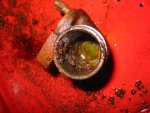- 4,640
- 28
- 38
- Location
- Cambridge, Ohio
Hello all,
I've been reading a lot of posts preparing to do my recovery in Sparta, WI here in a few weeks. I've read through the -10 TM and read, then read more, and finally read even more posts about the deuce. I've done a lot of searching but there are 2 nagging questions in the back of my mind I'm not 100% sure of the answers.
I've read a lot about the differences between the sprag and the airshift transfer cases. I'm about 80 to 90% sure mine has the airshift case. My question is pretty simple and the TM doesn't cover it well, if it did I missed it.
Can the front axle of the deuce be shifted "on the fly" like a lot of 4x4's, or should it be done while stopped. Can it be done while in gear with the clutch depressed or should the main transmission be in neutral? I'm also planning on installing lockout hubs down the road. I'm curious about going in and out of 6x6, some manual hubs on 4x4's, you need to back up a few feet after disengaging the front hubs to make sure they fully disengaged. Is this the case with the ones used on the deuce?
Now to the braking question. It seems to me that there are a lot of posts dealing with bleeding the brakes and working on master cylinders, air packs and wheel cylinders.
Are the deuce brakes really that much of an unreliable PITA all the time or is it just a few unlucky souls who seem to have a lot of trouble with their brakes? I would really hate to have to bleed the brakes or worry about them failing every time I go to take her out for a drive.
I'm sure these are stupid newbie questions but I can't seen to find definite answers by searching so it's time to ask the pro's. Thanks in advance guys.
I've been reading a lot of posts preparing to do my recovery in Sparta, WI here in a few weeks. I've read through the -10 TM and read, then read more, and finally read even more posts about the deuce. I've done a lot of searching but there are 2 nagging questions in the back of my mind I'm not 100% sure of the answers.
I've read a lot about the differences between the sprag and the airshift transfer cases. I'm about 80 to 90% sure mine has the airshift case. My question is pretty simple and the TM doesn't cover it well, if it did I missed it.
Can the front axle of the deuce be shifted "on the fly" like a lot of 4x4's, or should it be done while stopped. Can it be done while in gear with the clutch depressed or should the main transmission be in neutral? I'm also planning on installing lockout hubs down the road. I'm curious about going in and out of 6x6, some manual hubs on 4x4's, you need to back up a few feet after disengaging the front hubs to make sure they fully disengaged. Is this the case with the ones used on the deuce?
Now to the braking question. It seems to me that there are a lot of posts dealing with bleeding the brakes and working on master cylinders, air packs and wheel cylinders.
Are the deuce brakes really that much of an unreliable PITA all the time or is it just a few unlucky souls who seem to have a lot of trouble with their brakes? I would really hate to have to bleed the brakes or worry about them failing every time I go to take her out for a drive.
I'm sure these are stupid newbie questions but I can't seen to find definite answers by searching so it's time to ask the pro's. Thanks in advance guys.



